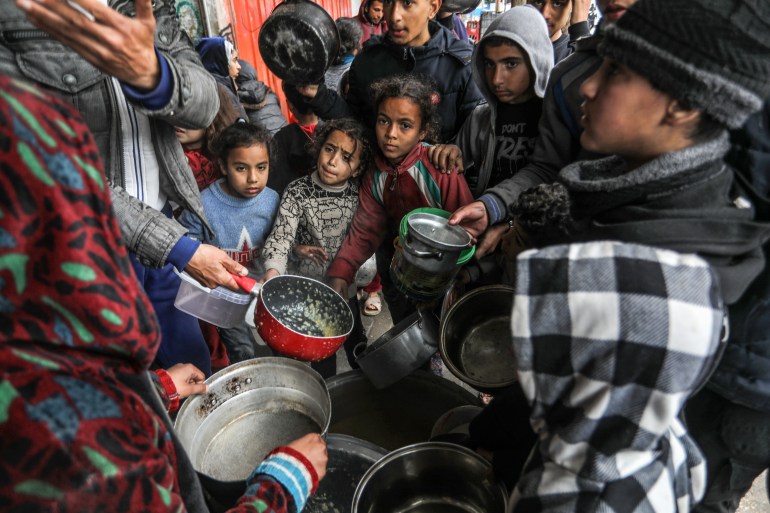ARTICLE AD
Delivery falls far short of the minimum UN requirement to stave off the ongoing humanitarian crisis in the besieged territory.
Published On 8 Apr 2024
Israel has announced the entry of more than 300 aid trucks into Gaza, the highest daily volume since its war on the besieged territory began six months ago.
But Monday’s delivery still falls far short of what the United Nations says is the minimum required to feed millions of people – most of them refugees – on the brink of starvation.
Under growing international pressure, Israel on Monday said 322 aid trucks were inspected and allowed to enter the heavily bombarded Palestinian territory.
In a statement on X, Israel’s Coordinator of Government Activities in the Territories (COGAT) said 228 of the trucks, which represents 70 percent of the total number, were carrying food.
Al Jazeera monitored some of the trucks going through the southern Rafah crossing with Egypt. Other trucks also went through the Karem Abu Salem crossing, known as Kerem Shalom to Israelis, according to Al Jazeera’s Tarek Abu Azzoum, reporting from Rafah.
He said most of the humanitarian convoys were loaded with water, sugar, flour and other basic necessities.
None of the trucks from the south, however, was allowed to reach the northern part of Gaza, which according to the UN and other humanitarian groups, is facing famine, he added.
A spokesman of the authority managing the crossing in Rafah also told Al Jazeera that the delivery is just a fraction of what was going through before the war.
“The strip is suffering from major famine, especially in the northern regions and Gaza City. The south is also suffering from a major humanitarian catastrophe. Therefore, bringing aid in this daily manner is not sufficient,” Hisham Adwan said.
UN aid agencies and other humanitarian groups now say Gaza needs at least 500 to 600 trucks of humanitarian aid and commercial goods daily to sustain the dire situation in the besieged territory.
According to estimates, about 1.5 million of those displaced from northern and central Gaza are now sheltering in the southernmost city of Rafah, whose future remains uncertain in the face of constant Israeli bombardment and threats of a ground invasion.
Severe restrictions
Severe restrictions imposed by Israel have resulted in an average of 20 to 25 trucks being turned away every day in Gaza. On some days since October 7, only about 100 to 150 trucks were allowed to enter.
In recent weeks, the United States warned Israel it must commit to protecting civilians and aid workers and delivering more humanitarian aid or risk losing US support.
Israel said measures are being taken to accelerate the inspection, transfer and distribution of aid to Gaza, adding that 257,530 tonnes of food in 12,197 trucks have entered Gaza since October 7.
 Palestinians holding empty bowls receive food distributed by volunteers of charities as people facing hunger crisis and famine risk due to the Israeli embargo imposed on Gaza [File: Abed Rahim Khatib/Anadolu Agency]
Palestinians holding empty bowls receive food distributed by volunteers of charities as people facing hunger crisis and famine risk due to the Israeli embargo imposed on Gaza [File: Abed Rahim Khatib/Anadolu Agency]
But Sean Carroll, head of the American Near East Refugee Aid organisation, said daily deliveries have to be much higher, and that agencies still do not have proper security assurances from Israel when they enter Gaza.
“To make up ground to meet the extreme gaps in food and other essentials for living, we need to see more than 500 trucks a day,” he told Al Jazeera.
“The real issue is, who is going to deliver all these aid,” he asked, adding that UNRWA, the UN relief agency for Palestinians, is blocked from delivering aid to northern Gaza.
Following the deadly incident involving seven World Central Kitchen staff, he said, humanitarian workers are “extremely nervous” to do their work in Gaza.
Source
:
Al Jazeera and news agencies

 11 months ago
63
11 months ago
63 
